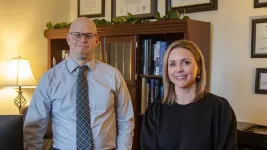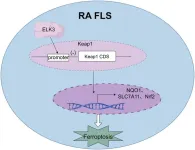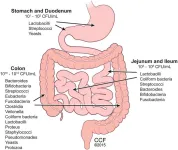(Press-News.org) While the restoration of natural areas is high on political agendas, a comprehensive new study from the University of Copenhagen shows that – after more than two decades – biodiversity growth has stalled in restored Danish wetlands. The results also suggest that time alone will not heal things because the areas are too small and dry, and nitrogen inputs from agriculture continue. According to the researchers, we need to learn from the past.
The benefits are clear: natural areas with high biodiversity absorb CO2 and can help struggling marine environments by reducing nitrogen emissions.
The establishment of wetlands ranks high among the green priorities of politicians in Denmark and many other countries. And with the new Green Tripartite Agreement between the government, industry, agriculture and environmental groups, Denmark plans to invest significantly in restoring natural areas in coming years, with the creation of new wetlands being a key focus.
However, new research from the University of Copenhagen’s Department of Biology emphasizes that these initiatives must be executed with careful consideration. The study, which is the first detailed investigation of biodiversity in restored wetlands in Denmark, describes the restoration of Danish wetlands as a "modest success." Despite decades of restoration efforts, biodiversity has stalled far from the goal line.
"Our study shows that species richness is significantly lower in restored wetlands than in original, natural wetlands. Furthermore, these areas are dominated by a few competitive species, while rarer and more vulnerable plants and mosses fail to establish themselves. In fact around one third of species found in near natural wetlands are missing, and it's all the rare species that are missing," explains Marta Baumane from the University of Copenhagen’s Department of Biology.
Few to no moss species were to be found after the restorations, and the species-rich genus “Carex”, typical of natural wetlands, were also underrepresented in restored wetlands. Researchers found only five common species of Carex in restored areas, compared to ten different species – several rare - in the near natural wetlands.
Baumane is the lead author of the study, now published in the scientific journal Journal of Applied Ecology. The researchers examined plant biodiversity using available data on wetlands across the Denmark and their own fieldwork at 72 different sites in three river valleys: Omme, Odense, and Tryggevælde. All of the wetlands studied were reestablished after 2000.
Time will not heal it
The results also make it clear that allowing for more time is not the solution to struggling biodiversity, as long as the underlying causes remain unchanged.
"If we waited another 20 years and returned, it is doubtful that we would see any significant improvements. Using the registry data, we can look back and find records showing that these areas have stagnated for the past 10 years. We must assume that this is due to a number of underlying factors that have yet to change. High concentrations of nitrogen remain in the soil and though the streams have been meandered again, they are often still in deep river channels, so the wetlands along them are too dry," says Marta Baumane.
In part, nitrogen residue comes from the land’s previous use for high-input farming, but it also continues to flow in from neighbouring areas with active farming.
At the same time, the research reports that many areas are too small and affected by incomplete watercourse restorations. These areas still show signs of dredged rivers and streams, as well as artificial drainage systems, which continue to dry out the land and, according to the researchers, prevent a natural ecosystem from developing in restored wetlands.
Grazers, meandered streams and an end to slurry drainage mark the way forward
Recognizing the problems should be the first step toward solving them if you ask the researchers. Based on their new research, Baumane and her colleagues highlight several concrete measures that could improve biodiversity in both older and more recently restored wetlands.
One of the key recommendations is the use of grazing animals. The study shows that grazed restored wetlands have significantly more plant species richness compared to areas that have been left unmanaged. Indeed, grazers create a more diverse landscape, with favourable conditions for a wider range of species.
"In particular, grazing reduces the overgrowth of tall grasses, which makes space for low-growing plant species and mosses that would otherwise be outcompeted," explains Marta Baumane.
At the same time, the researchers recommend that efforts be made to reduce the amount of nutrient-laden drainage water discharged from surrounding fields and ensure full restoration of watercourses so that the areas have the right conditions to become true wetlands.
Natural grazing, water conditions and less nutrients are easier to achieve in larger contiguous areas than in small isolated areas surrounded by agriculture. The researchers' recommendation to create larger areas also harmonizes with a final recommendation for future projects, namely that they are placed near existing natural areas with high biodiversity, from which plants and other organisms can spread to the new wetlands.
A failure to prioritize biodiversity
According to the researchers, the projects included in the study reflect a political approach to wetland restoration where the primary goal has been to reduce nutrient inputs into waterways so as to improve freshwater and marine environments. Essentially becoming open air waste water treatment plants. They point out that biodiversity is frequently mentioned in project descriptions, but without a clearly defined objective.
“If we continue to treat the country's natural areas one-sidedly as a technical solution to our nutrient and CO2 emissions, it will continue to cost us biodiversity,” emphasizes Marta Baumane, who is supported by co-author Professor Hans Henrik Bruun from the Department of Biology.
"To avoid repeating the same mistakes in new wetland areas, biodiversity should be prioritized in future projects, for example in connection with the Green Tripartite. If Denmark is to achieve its biodiversity goals, it requires a much more ambitious effort," he says.
*
Facts: Moss is a strong indicator
Few - often no - moss species were found in the new wetlands studied. Research shows that the diversity of mosses is high in semi-natural areas, while dense grass vegetation in restored wetlands leaves no room for them. Mosses can therefore be important indicators of biodiversity in wetlands. The researchers suggest that mosses can be used to assess whether restoration projects are on the right track.
Facts: No natural wetlands in Denmark, only near-natural
Denmark is so extensively cultivated that even the wetlands that the researchers used as a reference, i.e. a natural basis for comparison, are also highly influenced by humans and could not be described as fully natural.
Even though these areas have not been cultivated, they are so small and isolated, surrounded by agriculture and without natural watercourses etc. that an actual natural state is not present. Instead, researchers coined the term “near-natural”.
Facts: About the Study
• The study aims to assess the restoration of wetlands.
More specifically, it examines how the area's fertilization history, stream restoration, grazing, and species pool in the surroundings influence the achieved plant diversity compared to near-natural wetlands.
• The study was conducted on two spatial scales: landscape and local site.
At the landscape level, monitoring data from 48 restored wetlands across Denmark were used (including data on grazing density, water conditions, soil type, and other variables).
At the local site level, researchers compared vegetation, soil moisture, and nutrient levels in wetlands in three river valleys: Omme, Odense, and Tryggevælde. In each valley, four types of wetlands were studied: restored wetland with grazing [RG], restored ungrazed [RU], near-natural grazed [NG], and near-natural ungrazed [NU].
Behind the research
The following researchers where part of the research project - all from the Department of Biology, University of Copenhagen:
Marta Baumane
Lars Baastrup-Spohr
Kaj Sand-Jensen
Irina Goldberg
Kenneth Thorø Martinsen
Hans Henrik Bruun
END
Twenty years on, biodiversity struggles to take root in restored wetlands
While the restoration of natural areas is high on political agendas, a comprehensive new study from the University of Copenhagen shows that – after more than two decades – biodiversity growth has stalled in restored Danish wetlands.
2025-02-07
ELSE PRESS RELEASES FROM THIS DATE:
Do embedded counseling services in veterinary education work? A new study says “yes.”
2025-02-07
COLUMBIA, Mo. -- Embedded counseling services are becoming increasingly common in veterinary medical programs, but their effectiveness has not historically been measured. A new study by University of Missouri researchers revealed that these programs may not only enhance access to mental health care but also lead to significant reductions in psychological distress among veterinary trainees.
“It’s the first study, as far as we know, to evaluate the effectiveness of mental health counseling for veterinary trainees,” said Kerry Karaffa, PhD, a licensed psychologist at the ...
Discovery of unexpected collagen structure could ‘reshape biomedical research’
2025-02-07
Collagen, the body’s most abundant protein, has long been viewed as a predictable structural component of tissues. However, a new study led by Rice University’s Jeffrey Hartgerink and Tracy Yu, in collaboration with Mark Kreutzberger and Edward Egelman at the University of Virginia (UVA), challenges that notion, revealing an unexpected confirmation in collagen structure that could reshape biomedical research.
The researchers used advanced cryo-electron microscopy (cryo-EM) to determine the atomic structure of a packed collagen assembly that deviates from the traditionally accepted right-handed superhelical twist. ...
Changes in US primary care access and capabilities during the COVID-19 pandemic
2025-02-07
About The Study: In this cohort study, over the time period including the COVID-19 pandemic, primary care practices reported a decline in access to care, while average practice capabilities improved. Integrated practice ownership and accountable care organization participation were both associated with better access and capability scores, suggesting that value-based payment and integrated care delivery support the development of higher-quality primary care. Variations across practices point to large opportunities for improvement overall and underscore the importance of incentives and structures as levers to improve primary care delivery.
Corresponding Author: To contact the ...
Cardiometabolic trajectories preceding dementia in community-dwelling older individuals
2025-02-07
About The Study: In this study of older individuals, decline in body mass index, waist circumference, and high-density lipoprotein (HDL) occurred up to a decade before dementia diagnosis. These findings provide insights into cardiometabolic changes preceding dementia and the potential for early monitoring and intervention.
Corresponding Author: To contact the corresponding author, Zimu Wu, PhD, email zimu.wu1@monash.edu.
To access the embargoed study: Visit our For The Media website at this link https://media.jamanetwork.com/
(doi:10.1001/jamanetworkopen.2024.58591)
Editor’s Note: Please see the article for additional information, ...
Role of ELK3 in ferroptosis of rheumatoid arthritis fibroblast-like synoviocytes
2025-02-07
Background and objectives
Rheumatoid arthritis (RA) is an inflammatory arthritis characterized by chronic joint inflammation, cartilage degradation, and bone erosion. ELK3 is a transcriptional repressor that can affect cell proliferation, migration, invasion, apoptosis, and other cellular processes. The study aimed to clarify the effect of ELK3 in the biological activity and ferroptosis phenotype of RA fibroblast-like synoviocytes (FLS), and to reveal its molecular mechanism in regulating ferroptosis in RA FLS.
Methods
We investigated the impact of ELK3 on the biological activity and ferroptosis phenotype of RA FLS using real-time quantitative polymerase chain reaction, immunohistochemistry, ...
Team of Prof. Woo Young Jang Department of Orthopedic Surgery, KU Anam Hospital wins the Best Paper Award from the Korean Musculoskeletal Tumor Society
2025-02-07
Professor Woo Young Jang (Department of Orthopedic Surgery, Korea University Anam Hospital) recently won the best paper award at the 2024 fall academic conference of the Korean Musculoskeletal Tumor Society held in November 22th, 2024. This award recognizes the outstanding results and academic value of the research led by Professor Jang.
Professor Woo Young Jang, in collaboration with Professor Jun Seok Lee from the Department of Pharmacology and Dr. Jang Sun Hwang from the Department of Orthopedic Surgery at Korea University College of Medicine, conducted the research ‘Disaggregation-Activated ...
Terasaki Institute for Biomedical Innovation announces recipients of inaugural Keith Terasaki Mid-Career Innovation Award
2025-02-07
Los Angeles, CA – February 7, 2025 - The Terasaki Institute for Biomedical Engineering (TIBI) is pleased to announce their selection of Dr. Liangfang Zhang - Irwin Jacobs Chancellor’s Endowed Chair Professor at the University of California San Diego, and Dr. Aydogan Ozcan – Chancellor’s Professor, UCLA & Professor, Howard Hughes Medical Institute (HHMI), as the recipients of the inaugural Keith Terasaki Mid-Career Innovation Award. These awards will be presented at the 3rd Annual Terasaki Innovation Summit, to be held March ...
The impact of liver graft preservation method on longitudinal gut microbiome changes following liver transplant
2025-02-07
Background and Aims
End-stage liver disease is associated with disruptions in gut microbiota composition and function, which may facilitate gut-to-liver bacterial translocation, impacting liver graft integrity and clinical outcomes following liver transplantation. This study aimed to assess the impact of two liver graft preservation methods on fecal microbiota and changes in fecal and breath organic acids following liver transplantation.
Methods
This single-center, non-randomized prospective pilot study enrolled liver transplant patients whose grafts were preserved using either static cold storage or ex situ normothermic machine perfusion (NMP). Fresh stool ...
Cardiovascular health risks continue to grow within Black communities, action needed
2025-02-07
DALLAS, Feb. 7, 2025 — The American Heart Association’s 2025 Heart Disease and Stroke Statistical Update reports that while progress has been made in reducing cardiovascular and cerebral health disparities, Black communities in the United States still face disproportionately higher risk of heart disease, stroke and hypertension. These gaps subsequently contribute to equally disproportionate high death rates, underscoring the urgent need for lifesaving intervention. As part of its nationwide Heart Month and Black History Month activations, the ...
ALS survival may be cut short by living in disadvantaged communities
2025-02-07
Living in a disadvantaged community may decrease the length of time a person can survive with amyotrophic lateral sclerosis, or ALS, by over 30%, a Michigan Medicine-led study suggests.
ALS is a progressive, incurable condition that causes muscle wasting and loss of muscle control.
While most people survive with ALS around two to four years, some people can live significantly longer.
In the study of more than 1,000 patients with ALS seen between 2012 and mid-2024, people from the most disadvantaged neighborhoods had up to a 37% ...
LAST 30 PRESS RELEASES:
Tracing the quick synthesis of an industrially important catalyst
New software sheds light on cancer’s hidden genetic networks
UT Health San Antonio awarded $3 million in CPRIT grants to bolster cancer research and prevention efforts in South Texas
Third symposium spotlights global challenge of new contaminants in China’s fight against pollution
From straw to soil harmony: International team reveals how biochar supercharges carbon-smart farming
Myeloma: How AI is redrawing the map of cancer care
Manhattan E. Charurat, Ph.D., MHS invested as the Homer and Martha Gudelsky Distinguished Professor in Medicine at the University of Maryland School of Medicine
Insilico Medicine’s Pharma.AI Q4 Winter Launch Recap: Revolutionizing drug discovery with cutting-edge AI innovations, accelerating the path to pharmaceutical superintelligence
Nanoplastics have diet-dependent impacts on digestive system health
Brain neuron death occurs throughout life and increases with age, a natural human protein drug may halt neuron death in Alzheimer’s disease
SPIE and CLP announce the recipients of the 2025 Advanced Photonics Young Innovator Award
Lessons from the Caldor Fire’s Christmas Valley ‘Miracle’
Ant societies rose by trading individual protection for collective power
Research reveals how ancient viral DNA shapes early embryonic development
A molecular gatekeeper that controls protein synthesis
New ‘cloaking device’ concept to shield sensitive tech from magnetic fields
Researchers show impact of mountain building and climate change on alpine biodiversity
Study models the transition from Neanderthals to modern humans in Europe
University of Phoenix College of Doctoral Studies releases white paper on AI-driven skilling to reduce burnout and restore worker autonomy
AIs fail at the game of visual “telephone”
The levers for a sustainable food system
Potential changes in US homelessness by ending federal support for housing first programs
Vulnerability of large language models to prompt injection when providing medical advice
Researchers develop new system for high-energy-density, long-life, multi-electron transfer bromine-based flow batteries
Ending federal support for housing first programs could increase U.S. homelessness by 5% in one year, new JAMA study finds
New research uncovers molecular ‘safety switch’ shielding cancers from immune attack
Bacteria resisting viral infection can still sink carbon to ocean floor
Younger biological age may increase depression risk in older women during COVID-19
Bharat Innovates 2026 National Basecamp Showcases India’s Most Promising Deep-Tech Ventures
Here’s what determines whether your income level rises or falls
[Press-News.org] Twenty years on, biodiversity struggles to take root in restored wetlandsWhile the restoration of natural areas is high on political agendas, a comprehensive new study from the University of Copenhagen shows that – after more than two decades – biodiversity growth has stalled in restored Danish wetlands.





